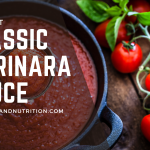From Naples to Your Kitchen: Unveiling the Magic of Homemade Pizza Sauce

When it comes to pizza, the sauce plays a crucial role in elevating the flavors and creating a culinary masterpiece. While store-bought pizza sauces offer convenience, there’s something truly special about making your own pizza sauce from scratch. In this blog post, we’ll explore the history, popularity, ingredients, nutrition, and serving ideas of homemade pizza sauce. By the end, you’ll be convinced that crafting your own sauce is a game-changer for your pizza creations.
The History of Pizza Sauce
The history of pizza sauce dates back to ancient times, originating in Naples, Italy. Traditional Neapolitan pizza, known for its simplicity, uses a base of crushed tomatoes, garlic, oregano, and olive oil. This classic combination inspired countless variations and has become the foundation of pizza sauce worldwide.
Why Homemade Pizza Sauce is Popular
The popularity of homemade pizza sauce stems from several factors. First, it allows you to customize the flavors to suit your taste preferences. By adjusting the herbs, spices, and seasonings, you can create a sauce that perfectly complements your chosen pizza toppings. Second, making your own sauce gives you complete control over the quality and freshness of the ingredients. It’s an opportunity to use high-quality tomatoes, aromatic herbs, and wholesome spices, resulting in a superior taste. Lastly, the satisfaction and pride that come with crafting a sauce from scratch add an extra layer of enjoyment to the pizza-making process.
Common Ingredients in Pizza Sauce
While the specific ingredients in pizza sauce can vary, there are some staples that provide the foundation for its distinctive taste. Tomato sauce, with its rich and tangy flavor, forms the base of most pizza sauces. Additional ingredients often include finely chopped onion, garlic, basil leaves, oregano, black pepper, sugar, and salt. These ingredients work together to create a harmonious balance of flavors, enhancing the overall pizza experience.
PIZZA SAUCE
Ingredients
- 15 ounces tomato sauce
- 1 medium onion — finely chopped
- ½ teaspoon basil leaves
- ½ teaspoon oregano
- ½ teaspoon black pepper — fresh cracked
- ½ teaspoon garlic powder
- 2 tablespoons sugar
- 1 ½ teaspoons salt
Instructions
- Heat a pan over medium heat and sauté the finely chopped onion until translucent.
- Add the tomato sauce to the pan and bring it to a simmer.
- Stir in the basil leaves, oregano, black pepper, garlic powder, sugar, and salt. Mix well.
- Reduce the heat to low and let the sauce simmer for about 20 minutes, allowing it to thicken and the flavors to meld together.
- Use an immersion blender or transfer the sauce to a blender and puree until smooth.
- Taste the sauce and adjust the seasoning according to your preference.
- Use the sauce immediately or store it in an airtight container in the refrigerator for up to a week.
Notes
Nutritional Benefits of Homemade Pizza Sauce
Pizza sauce, when prepared with fresh and wholesome ingredients, offers more than just taste. Tomatoes, the star ingredient, are packed with essential nutrients such as vitamins A, C, and K, as well as lycopene, a powerful antioxidant. The herbs and spices used in pizza sauce, like basil and oregano, contribute additional vitamins, minerals, and antioxidants. By opting for homemade pizza sauce, you can control the amount of sugar and sodium, making it a healthier choice compared to some store-bought options.
Serving Ideas and Versatility
The beauty of homemade pizza sauce lies in its versatility. While it’s the perfect accompaniment to traditional cheese or Margherita pizzas, it can also be used as a flavorful base for a variety of pizza creations. Experiment with different variations such as the following:
- Gourmet Veggie Delight: Spread a generous amount of homemade pizza sauce on a thin, crispy crust, and top it with a medley of roasted vegetables like bell peppers, zucchini, eggplant, and cherry tomatoes. Sprinkle some mozzarella cheese and fresh basil leaves for a burst of flavor.
- Spicy Pepperoni Feast: For those who enjoy a kick of heat, slather your pizza dough with homemade sauce, then add a layer of pepperoni slices, diced jalapeños, and red chili flakes. Top it off with a generous amount of mozzarella and bake until golden and bubbling.
- Mediterranean Dream: Transport your taste buds to the Mediterranean with a Mediterranean-inspired pizza. Spread a generous layer of homemade pizza sauce and top it with crumbled feta cheese, sliced black olives, artichoke hearts, and a sprinkle of dried oregano. Drizzle with extra virgin olive oil before baking for a tangy and savory delight.
- BBQ Chicken Sensation: Combine the smoky flavors of barbecue sauce and homemade pizza sauce for a unique twist on a classic pizza. Top your dough with a mixture of the two sauces, cooked and shredded chicken, red onion slices, and a sprinkle of cheddar cheese. Bake until the cheese is melted and bubbly.
- Caprese Elegance: Showcase the simplicity of Italian flavors with a Caprese-inspired pizza. Spread a thin layer of homemade pizza sauce on a thin crust, then layer fresh mozzarella slices, ripe tomato slices, and fresh basil leaves. Drizzle with balsamic glaze and a sprinkle of sea salt before baking to perfection.
By exploring different combinations of toppings and flavors, you can create your own signature pizzas using the homemade pizza sauce as the foundation.
Conclusion
While it may be tempting to reach for a store-bought pizza sauce for convenience, the experience of making your own sauce is truly unparalleled. Not only do you have the freedom to adjust the flavors to suit your palate, but you also have control over the quality and freshness of the ingredients. The superior taste and nutritional benefits of homemade pizza sauce make it a healthier and more satisfying choice.
Incorporating homemade pizza sauce into your culinary repertoire allows you to elevate your pizza creations to new heights. The rich history, versatility, and endless possibilities make it a worthwhile endeavor. So, gather your ingredients, take a few extra minutes to prepare your own sauce, and savor the rewarding experience of crafting a homemade masterpiece that will leave your taste buds craving more.
Homemade pizza sauce adds a burst of flavor, authenticity, and customization to your homemade pizzas. Its rich history, popularity, versatile ingredients, and nutritional benefits make it a winning choice. By taking the time to prepare your own sauce, you can unleash your creativity in the kitchen and elevate your pizza-making skills. Embrace the art of homemade pizza sauce and embark on a flavorful journey that will leave you and your loved ones eagerly awaiting your next homemade pizza night.
- BBQ Chicken Pizza Recipe: A Delicious Fusion of Flavors

- Cuisinart Pizza Dough: The Shortcut to Homemade Pizza Bliss

- Unlock Classic Marinara Sauce: A Flavorful & Nutritious Guide

- The Nutritional Powerhouse: Bean Taco Pizza for a Wholesome Delight

- Bread Machine Pizza Dough: Your Secret Weapon for Quick and Delicious Homemade Pizza

- Wild and Wacky Mushroom and Pesto BOBOLI

